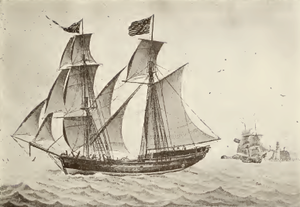Brigantine
| Brigantine | |
|---|---|

Brigantine Experiment of Newburyport, 114 tons, built at Amesbury in 1803
|
|
| Type | Sailing rig |
| Place of origin | Mediterranean |
The brigantine was a two-masted sailing vessel with a fully square rigged foremast and at least two sails on the main mast: a square topsail and a gaff sail mainsail (behind the mast). The main mast is the second and taller of the two masts.
Modern American definitions include vessels without the square sails on the main mast.
In the Mediterranean Basin during the 13th century, a brigantine referred to a sail- and oar-driven war vessel. It was lateen rigged on two masts and had between eight and twelve oars on each side. Its speed, maneuverability and ease of handling made it a favourite of Mediterranean pirates. Its name is derived from the Italian word , which in turn is derived from "brigand". Other than in names, this vessel has no relation to the later brigantines developed in Northern Europe.
By the 17th century the term was adapted by Atlantic maritime nations. The vessel had no lateen sails but was instead square-rigged on the foremast and had a gaff-rigged mainsail with square rig above it on the mainmast. The main mast of a brigantine is the aft one.
By the first half of the 18th century the word had evolved to refer not to a kind of vessel, but rather to a particular type of rigging: two-masted, with her foremast fully square-rigged and her mainmast rigged with both a fore-and-aft mainsail (a gaff sail) and square topsails and possibly topgallant sails.
The brigantine was the second most popular rig for ships built in the British colonies in North America before 1775 (the most popular type of vessel being a sloop). The brigantine was swifter and more easily maneuvered than a sloop or schooner, and was hence employed for purposes of piracy, espionage, and reconnoitering, and as an outlying attendant upon large ships for protecting a ship, or for supply or landing purposes in a fleet.
The brigantine could be of various sizes, ranging from 50 to 200 tons burden. The brigantine was generally larger than a sloop or schooner but smaller than a brig.
...
Wikipedia
